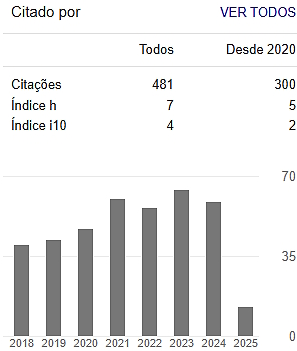O USO DE DEEP LEARNING APLICADO NO RECONHECIMENTO DE AÇÕES HUMANAS A PARTIR DE VÍDEOS EM ALTA RESOLUÇÃO VISANDO IDENTIFICAR MOVIMENTOS SUSPEITOS
Palavras-chave:
Deep Learning, Visão computacional, Segurança, Suspeitos, Yolo, CNN, Redes neurais convolucionais, Blazepose, KalmanResumo
A utilização de visão computacional desempenha um papel importante para fins de segurança. Porém, a combinação com técnicas de aprendizado profundo e redes neurais convolucionais ainda são pouco exploradas por demandarem bastante capacidade de processamento computacional. Este trabalho tem por objetivo combinar essas técnicas com o objetivo de gerar um algoritmo que seja capaz de identificar e rastrear indivíduos em vídeos, além disso, monitorar suas ações com o propósito de identificar movimentos que possam significar um ato criminoso, utilizando o algoritmo do YOLO para a identificação, filtro de Kalman para o rastreamento e BlazePose para a identificação dos movimentos.
Downloads
Referências
ALVES, G. Detecção de Objetos com YOLO – Uma abordagem moderna. 2020. Disponível em: https://iaexpert.academy/2020/10/13/deteccao-de-objetos-com-yolo-uma-abordagem-moderna/. Acesso em: 05 ago. 2021.
ALVES, G. Understanding ConvNets (CNN). 2018. Disponível em: https://medium.com/neuronio/understanding-convnets-cnn-712f2afe4dd3. Acesso em: 01 ago. 2021.
ANANTHAKUMAR, A.. Efficient Face And Gesture Recognition For Time Sensitive Application. Georgia. 2018. Disponível em: https://ieeexplore.ieee.org/document/8470351/authors#authors. Acesso em: 09 ago. 2021. https://doi.org/10.1109/SSIAI.2018.8470351
ARAÚJO, F. H. D. et al. Redes Neurais Convolucionais com Tensorflow: Teoria e Prática. In: Escola Regional de Informática do Piauí. 3., 2017. Picos, MA. Anais [...]. Picos: Sociedade Brasileira de Computação, 2017. Disponível em:https://docplayer.com.br/57119969-Redesneurais-convolucionais-com-tensorflow-teoria-e-pratica.html. Acesso: 25 ago. 2020.
BAZAREVSKY, V. et al. BlazePose: On-device Real-time Body Pose tracking. Seattle: CVPR Workshop on Computer Vision for Augmented and Virtual Reality, 2020. Disponível em: https://arxiv.org/abs/2006.10204>. Acesso em 08 nov. 2021.
BBC. Como funciona o ‘Big Brother’ da China, com 170 milhões de câmeras que fazem identificação visual. BBC, 2017. Disponível em: https://www.bbc.com/portuguese/internacional-42361047. Acesso em: 08 fev. 2021.
FACHRIE, M. A simple vehicle counting system using deep learning with YOLOv3 Model. 2020. Disponível em: https://www.researchgate.net/publication/341075968_A_Simple_Vehicle_Counting_System_Using_Deep_Learning_with_YOLOv3_Model. Acesso em: 26 set. 2021. https://doi.org/10.29207/resti.v4i3.1871
GOODFELLOW, J. Deep Learning. Cambridge, MA: MIT, 2016. Disponível em: https://books.google.com.br/books?hl=ptPT&lr=&id=omivDQAAQBAJ&oi=fnd&pg=PR5&dq=deep+learning+goodfellow+pdf&ots=MNO3gnpzQR&sig=hcU98sXLnC5jYgQBpfMWnDZtPCI#v=onepage&q=deep%20learning%20goodfellow%20pdf&f=false. Acesso em: 22 set. 2021.
HUBEL, D. H.; WIESEL, T. N. Receptive fields and functional architecture of monkey striate cortex. The Journal of Physiology, v. 195, n. 1, p. 215–243, mar. 1968.. https://doi.org/10.1113/jphysiol.1968.sp008455
JIACONDA. A Concise History of Neural Networks. Towards Data Science, 2016. Disponível em: https://towardsdatascience.com/a-concise-history-ofneuralnetworks-2070655d3fec. Acesso em: 09 ago. 2021.
KARPATHY, A. CS231n Convolutional Neural Networks for Visual Recognition. Disponível em: http://cs231n.github.io/convolutional-networks/. Acesso em: 15 ago. 2021.
LECUN, Y. et al. Gradient-Based Learning Applied to Document Recognition. Montréal, 1998. Disponível em: http://yann.lecun.com/exdb/publis/pdf/lecun98.pdf. Acesso em: 29 jul. 2021.
LIU, R. et al. An Improved YOLOV3 for Pedestrian Clothing Detection. In: INTERNATIONAL CONFERENCE ON SYSTEMS AND INFORMATICS. 6, 2019. Disponível em: https://ieeexplore.ieee.org/abstract/document/9010512. Acesso em: 15out. 2021. https://doi.org/10.1109/ICSAI48974.2019.9010512
MEDIAPIPE. Pose Landmark Model (BlazePose GHUM 3D), 2020. Disponível em: https://google.github.io/mediapipe/solutions/pose.html#pose-landmark-model-blazepose-ghum-3d. Acesso em: 08 nov. 2021.
NAVEGA, P. C. G.. Controle da Criminalidade: Problema de Polícia ou de Políticas?. Jus Navigandi, 2018. Disponível em: https://jus.com.br/artigos/64862/controle-da-criminalidade-problema-de-policia-ou-de-politicas. Acesso em: 08 mar. 2021.
SHEN, W.; WANG, W. Node Identification in Wireless Network Based on Convolutional Neural Network. In: INTERNATIONAL CONFERENCE ON COMPUTATIONAL INTELLIGENCE AND SECURITY. 2018. Disponível em: https://ieeexplore.ieee.org/abstract/document/8564297. Acesso em: 18 out. 2021. https://doi.org/10.1109/CIS2018.2018.00059
YUAN, L. et al. A convolutional neural network based on TensorFlow for face recognition. Lanzhou, 2017. Disponível em: https://ieeexplore.ieee.org/document/8054070 Acesso em: 13 ago. 2021.
WELCH, G..; BISHOP, G. An introduction to the kalman filter, Chapel Hill: University of North Carolina at Chapel Hill, 2006. Disponível em: https://www.cs.unc.edu/~welch/media/pdf/kalman_intro.pdf. Acess

